The pes of Australovenator wintonensis (Theropoda: Megaraptoridae): analysis of the pedal range of motion and biological restoration
- PMID: 27547591
- PMCID: PMC4975041
- DOI: 10.7717/peerj.2312
The pes of Australovenator wintonensis (Theropoda: Megaraptoridae): analysis of the pedal range of motion and biological restoration
Abstract
The pedal range of motion in Australovenator wintonensis is investigated to determine what influence soft tissue had on range of motion in the foot. Fortunately, the theropod pes shares a close morphology with extant large cursorial birds. Therefore, to better understand the pedal range of motion of Australovenator, the pedal range of motion of Dromaius novaehollandiae (commonly known as the emu) was analysed with and without soft tissue. We used a variety of innovative digital techniques to analyse the range of motion and biologically restore the Australovenator pes. Computed tomography scans of Dromaius pes in fully flexed and fully extended positions provided the soft tissue range of motion limits. The bone on bone range of motion of the same specimen was replicated following the removal of soft tissue. It was identified that there was an increase in range of motion potential with the removal of soft tissue. This variation provided a guide to develop the potential range of motion of a fully fleshed Australovenator pes. Additionally, the dissection of the Dromaius pes provided a guide enabling the replication of the corresponding soft tissue and keratin sheaths of the Australovenator pes.
Keywords: Australovenator; Dinosaurs; Foot print; Pes; Range of motion; Reconstruction; Theropod.
Conflict of interest statement
The authors declare there are no competing interests.
Figures

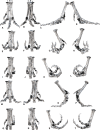
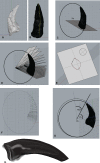



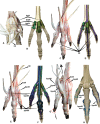
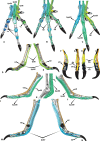
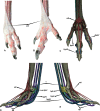

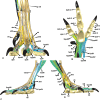
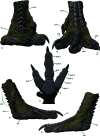

References
-
- Bonnan MF, Sandrik JL, Nishiwaki T, Wilhite DR, Elsey RM, Vitore C. Calcified cartilage shape in archosaur long bones reflects overlying joint shape in stress-bearing elements: implications for nonavian dinosaur locomotion. The Anatomical Record. 2010;293:2044–2055. doi: 10.1002/ar.21266. - DOI - PubMed
-
- Brooks A. On Dendragapus Obscurus Obscurus. The Auk. 1929;46:111–113. doi: 10.2307/4075798. - DOI
-
- Brusatte SL, Benson R, Hutt S. The osteology of Neovenator salerii (Dinosauria: Theropoda) from the Wealden Group (Barremian) of the Isle of Wight. Monograph of the Palaeontographical Society. 2008;162:1–75. doi: 10.1080/02724630903416092. - DOI
-
- Bryan SE, Cook AG, Allen CM, Siegel C, Purdy DJ, Greentree JS, Uysal T. Early—mid Cretaceous tectonic evolution of eastern Gondwana: from silicic LIP to continental rupture. Episodes Special Issue, Oceania Geology. 2012;35(1):142–152.
-
- Carpenter K. Forelimb biomechanics of nonavian theropod dinosaurs in predation. Senckenbergiana Lethaea. 2002;82:59–76. doi: 10.1007/BF03043773. - DOI
LinkOut - more resources
Full Text Sources
Other Literature Sources

